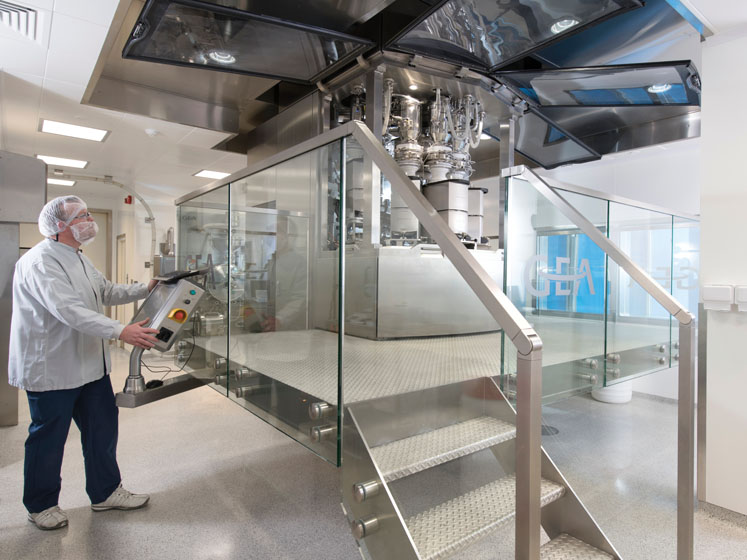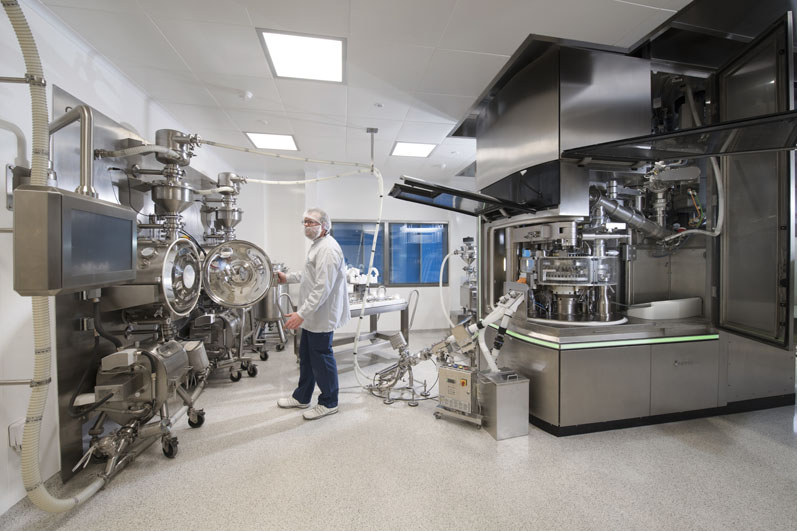Now gaining momentum in the pharmaceutical industry, continuous manufacturing (CM) presents a new approach to oral solid dosage (OSD) form production and meets the industry’s demands for faster product development, reduced costs and increased manufacturing flexibility.
Providing higher yields, lower utility consumption and reduced waste, CM is enabling drug makers to move away from traditional batch processing to a fully integrated and closely controlled process that gives excellent product consistency by intrinsic design.
Opening the event, GEA’s Phil Gabb, Head of Solid Dosage Sales Support, welcomed more than 150 delegates from 20 countries to the inaugural event and set the scene: “Highlighting the user experience and the practical application of CM, we’re about to discover the conti truth,” he said. “Environmentally friendly with a much smaller footprint, CM is helping the pharmaceutical industry to produce higher quality products, enhance drug safety and reduce its industrial footprint, which provides significant advantages to governments, companies and patients alike,” he added.
During a packed day of discussion and insight, GSK’s Ian Barylski, Scientific Leader, R&D, PAT, gave the opening presentation on “Perspectives of PAT for Continuous API and Drug Product Manufacture.” The use of CM technologies and inline PAT monitoring is a key driver of building quality by design (QbD) into the complete product lifecycle, from R&D through to manufacturing, with the ultimate aim of getting safer medicines to market in a more efficient and cost-effective way.
He summarised by saying that, in terms of CM, PAT delivers benefits such as increased process understanding, better model verification and the early detection of drift. Future applications include real-time release and integration as a component of APC models.
Next up, Prof. Alastair Florence, Director of the EPSRC Future Manufacturing Research Hub, Continuous Manufacturing and Advanced Crystallisation (CMAC), noted the use of continuous processes to improve both scale-down as well as scale-up, promoting miniaturisation to accelerate product development with less (valuable) API.

Currently using continuous crystallisation systems to implement a consistent, systematic approach to develop a mechanistic understanding of the process, acquire reliable data to inform model development and pre-empt common failure modes, he also advocated the future use of continuous micro-factories — a sequence of modular, configurable unit operations — to facilitate the deployment of new processes, offer better control and achieve a wide variety of industry relevant outcomes.
And, after a comprehensive presentation on development and control strategies, Scientist Bernd Van Snick from Janssen concluded that going conti delivers capable direct compression processes with high yields … and recommended that implementation needs to be simple yet effective! Using model-based supervisory advanced process control (APC) to capture unique equipment, material and PAT characteristics creates a system that increases precision and optimises the yield, capacity and OEE of the CM equipment.
Giving a true user perspective, Dr Sven-Oliver Borchert, Technology Expert, Process Performance Improvement, Bayer, discussed “Online Monitoring Continuous Pharmaceutical Production Processes.” The company’s MoBiDiK platform is a continuous technology system for the purification of mAbs.
The closed processing environment is both robust and fully automated. It benefits from Excel-based dashboards that facilitate the compilation and management of historical plant data.
Integrated SIPAT software improves process handling using chemometric tools and enables post-installation integrity testing and real-time trend detection.
Fanny Stauffer, Drug Product Lead, UCB Pharma, reminded us that CM delivers benefits in terms of reduced footprint, decreased costs, flexibility, improved process control, constant product quality and no scale-up during her talk on “Building a Facility Based Upon Continuous Manufacturing for OSD.” She also acknowledged that implementing CM is not a simple task and there will always be challenges to overcome.
Her advice was to talk — and listen — to your equipment supplier. “No one knows more about the technology than the companies who designed and built it. Their insight, guidance and expertise are invaluable,” she said.
And, closing the day’s debate and, perhaps, delivering the most poignant message, RCPE’s Executive Director, Scientific Operations, Massimo Bresciani, said: “Yes, we can use CM to make more complex products, reduce process variability, shorten supply chains, etc. But, is there one simple answer? No. Can we do it alone? No. Partnerships are paramount.” This was echoed by Jan Verelst, SIPAT Business Development Manager, Siemens, who reiterated that the key objectives of their partnership with GEA and Perceptive Engineering are to make a more standardised continuous manufacturing offering available to the pharmaceutical industry and lower the cost of entry.”
Making science work
The second day saw AstraZeneca’s Luis Martin de Juan talk about modelling and simulation, highlighting the benefits of collaboration and partnerships to expedite and optimise the implementation of continuous manufacturing. “Collaboration has been crucial,” said Luis, “and, depending on the business or technical challenge, several virtual models have been used to accelerate CM implementation.”
Admitting that “It’s still a work in process and some challenges remain,” he stressed that the integration of process understanding and modelling is critical to establishing CM technology. In summary, he concluded that virtual model systems can be used to enhance process design, reduce both time and costs during product development and support advanced process control strategies.
MSD’s Stephen Conway, Director, Center for Materials Science and Engineering, discussed “Technology Development for CDC and Coating,” praising CM’s ability to meet changing market demand, lower costs, ensure product quality and develop and launch new products more efficiently. He advised the delegates that, if you’re looking to gain global regulatory acceptance with a CM process, consider these four points:
- Formulation flexibility: What’s optimal for batch might not be optimal for CM; it’s critical to demonstrate bioequivalence
- Parallel production processes: Supply chain redundancy dictates that batch and CM processes must coexist
- Consistent control and release strategies: Assess the level of redundancy (RTD model vs RTD + blend NIR), sampling requirements and RTRT versus end product testing
- Flexible batch size: Investigate production duration and rate, and assess the future ability to expand.
On the road to CPI
Taking a break from the lecture theatre, delegates were invited to visit the CPI’s National Formulation Centre. Dr Barrie Rhodes described the organisation’s role as an innovator and explained how the CPI uses market-agnostic tech transfer to develop, prove and commercialise next-generation products, process and services during an excellent an educational visit.
He also described how the organisation aims to derisk innovation and accelerate the translation from invention to invoice. Highlights included a tour of the well-equipped product development labs and a demonstration of the lab-scale ConsiGma 1 being used to optimise wet granulation.
Site visit: MSD Cramlington
It was an early start for delegates on day three as we headed to Cramlington to visit MSD. The company has recently installed a ConsiGma Continuous Direct Compression (CDC 50), two ConsiGma Coaters, a Bruker Tandem and is utilising PAT technology from Siemens.
MSD sees “going conti” as an enabler of modernised drug production, offering better product quality, lower costs and more flexibility. At the same time, they’re equally aware that there’s a burden of management associated with implementing too much PAT and advise that “balance is key to optimisation.”

However, Andrew Owen, Production Manager, also described the ConsiGma continuous coater as a game changer for the pharmaceutical manufacturing industry, even for friable cores. “Adopting continuous manufacturing is not just about equipment, he said: “It’s a business and strategy issue and requires taking a different approach to aspects such as validation.”
The MSD Cramlington plant was designed and built with both CM and data integrity in mind. And now, the company is asking whether any and all new drug products are CM-compatible. They’re making a firm commitment to the technology. Furthermore, they expect to see a growth in dual registrations for novel drug products and are currently planning to validate a 40-hour run at a throughput of 7 kg/h on the CDC 50.
Questions and answers
Returning to the venue for an energetic Q&A session and summary, Phil Gabb took to the podium. Asked how long it will take Big Pharma to covert to CM, he reminded us: “It’s an evolutionary process not a revolution. A whole mindset change is required and we’ll need to look at quality in a completely different way. It’s going to take time, but many companies have already started ... and we expect this to accelerate.”
And, addressing long lead times (point of order to point of delivery), he admitted that it has been an issue in the past because each system has been specifically engineered and developed for a certain application.
“Now, more ‘standardised’ systems are available and can be supplied quicker,” he answered.
Responding to an enquiry about how many CDCs or CTLs would be required to replace existing batch systems, Phil says: “Hundreds, but some highly efficient, large-scale batch processes will never be replaced ... because they don’t need to be.” And, finally, tackling a question about CM’s ability to handle low dosage APIs, the panel said: “Having run low percentage API formulations (down to 0.027%) successfully and overcome feeding issues, CM is manifestly suitable for both small ‘batches’ and low volume, high value products.”
In review
Reflecting on the three days, Fanny Stauffer commented: “The event has been a great opportunity to initiate discussions with actual players in the field of continuous manufacturing. The experience and the lessons learnt that the speakers shared were extremely valuable and gave a very comprehensive overview of the current understanding and the remaining challenges in terms of implementing different continuous process technologies for the pharmaceutical industry.”
Luis added: “This was a great event during which the pharmaceutical community got to know more about the state of implementation of continuous manufacturing by different companies. The level of detail shared was very impressive, particularly for someone coming from a different industrial sector. Plus, the amount of collaboration throughout the pharmaceutical industry regarding CM is outstanding and I believe that it will lead to a significant step forward to improve both future medicines and the patient experience.”
Offering the final word, Phil Gabb thanked the hosts, speakers and delegates by commenting: “This event was just an idea until you, by attending and contributing, made it a reality. We’re extremely grateful for all the input and lively discussions, and look forward to welcoming you to the next edition.”





